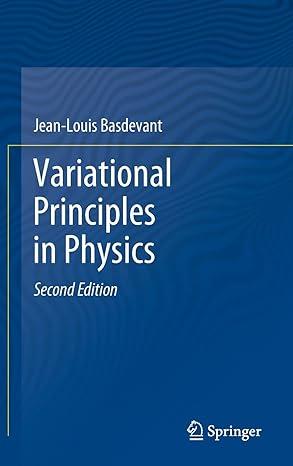In this Euclidean plane, the energy of the particle is [ E=frac{1}{2} mleft(dot{x}^{2}+dot{y}^{2}ight)+V ] where the effective
Question:
In this Euclidean plane, the energy of the particle is
\[
E=\frac{1}{2} m\left(\dot{x}^{2}+\dot{y}^{2}ight)+V
\]
where the "effective potential" \(V\) is energy dependent:
\[
V=\frac{1}{2} m \frac{ho^{2} \dot{ho}^{2}}{R^{2}-ho^{2}}=\frac{E ho^{2}}{R^{2}}
\]
Therefore, the motion also appears as a two-dimensional harmonic motion whose frequency \(\Omega\) depends on the total energy \(E\),
\[
\Omega^{2}=\frac{2 E}{m R^{2}}
\]
Consider the case of free motion on the three-dimensional "spherical" space of a sphere \(\mathbf{S}^{3}\) imbedded in \(\mathcal{R}^{4}\)
Obviously, the volume of this space is finite since \(ho^{2}=x^{2}+y^{2}+z^{2} \leq R^{2}\).
In spherical coordinates, the Lagrangian of the problem is
\[
\mathcal{L}=\frac{m}{2}\left(\dot{ho}^{2}\left(\frac{R^{2}}{R^{2}-ho^{2}}ight)+ho^{2} \dot{\theta}^{2}+ho^{2} \sin ^{2} \theta \dot{\phi}^{2}ight) .
\]
Prove the conservation laws of the problem which bring simplifications to the motion:
1. There is rotational invariance. The angular momentum is conserved, and the motion occurs on a plane.
2. We can choose the direction of the angular momentum as polar axis; i.e., \(\theta=\pi / 2\) and \(\dot{\theta}=0\).
3. The Lagrangian of the planar motion therefore reduces to
\[
\mathcal{L}=\frac{m}{2}\left(\dot{ho}^{2}\left(\frac{R^{2}}{R^{2}-ho^{2}}ight)+ho^{2} \dot{\phi}^{2}ight)
\]
4. The conservation of angular momentum, second Kepler's law, results in
\[
\frac{d}{d t}\left(ho^{2} \dot{\phi}ight)=0 \Longrightarrow \dot{\phi}=\frac{A}{ho^{2}}
\]
where \(A\) is a constant, fixed by the initial conditions.
5. The energy, which is a constant of the motion, is therefore
\[
E=\frac{m}{2}\left(\dot{ho}^{2} \frac{R^{2}}{R^{2}-ho^{2}}+\frac{A^{2}}{ho^{2}}ight)
\]
The two constants of the motion \(E\) and \(A\) satisfy the inequality
\[
A^{2} \leq \frac{2 R^{2} E}{m}
\]
which is a direct consequence of the fact that the energy is greater than the rotational energy \(m A^{2} / 2 ho^{2}\). This is a consequence of (7.135); i.e., \(E \geq m A^{2} / 2 ho^{2} \geq\) \(m A^{2} / 2 R^{2}\).
The Eqs. (7.134) and (7.135) are first-order differential equations that determine the motion in terms of the constants of the motion \(E\) and \(A\).
The solution is simple. We define parameters \(\omega\) and \(\gamma\) by
\[
\omega^{2}=\frac{2 E}{m R^{2}} \quad \text { and } \quad \gamma^{2}=\frac{m A^{2}}{2 E R^{2}}
\]
From (7.136), we have the inequality
\[
\gamma^{2} \leq 1
\]
Setting
\[
ho=R \cos (\omega \psi) ; \quad \text { i.e., } \quad \dot{ho}=-\omega \dot{\psi} R \sin (\omega \psi) \text {. }
\]
If we insert this in Eq. (7.135), we obtain
\[
\omega^{2}=\omega^{2} \dot{\psi}^{2}+\frac{\omega^{2} \gamma^{2}}{\cos ^{2}(\omega \psi)}
\]
i.e.,
\[
\omega^{2} \dot{\psi}^{2} \cos ^{2}(\omega \psi)=\omega^{2}\left(\cos ^{2}(\omega \psi)-\gamma^{2}ight)
\]
We now make the change of functions
\[
\sin (\omega \psi(t))=\sqrt{1-\gamma^{2}} u(t) ; \quad \text { therefore } \cos ^{2}(\omega \psi)=1-\left(1-\gamma^{2}ight) u^{2} \text {. }
\]
Show that the choice
\[
u(t)=\sin (\omega \zeta(t))
\]
leads with no difficulty to:
\[
\dot{\zeta}^{2}=1, \quad \text { namely } u=\sin \left(\omega\left(t-t_{0}ight)ight)
\]
and to the result, i.e. The expressions of \(ho(t), \tan \left(\phi(t)-\phi_{0}ight)\) as well as the frequency \(\omega\).
\[
ho(t)=R \sqrt{\cos ^{2} \omega\left(t-t_{0}ight)+\gamma^{2} \sin ^{2} \omega\left(t-t_{0}ight)}
\]
which is periodic and of frequency \(\omega\). The calculation of the time evolution of the azimuthal angle \(\phi(t)\) is obtained by this expression and Eq. (7.134),
\[
\dot{\phi}=\frac{A}{R^{2}\left(\cos ^{2} \omega\left(t-t_{0}ight)+\gamma^{2} \sin ^{2} \omega\left(t-t_{0}ight)ight)} ;
\]
i.e.,
\[
\tan \left(\phi(t)-\phi_{0}ight)=\gamma \tan \omega\left(t-t_{0}ight)
\]
which is also periodic and of frequency \(\omega\).
We conclude the following.
Step by Step Answer:






